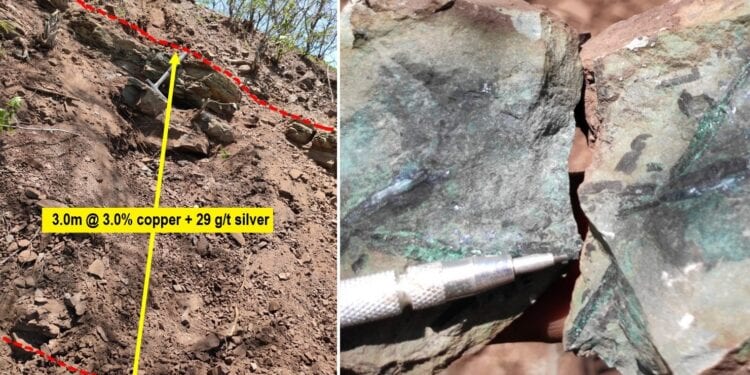Discovery Takes Strike Out To 29 Sq.Km
Max Resource Corp. (TSXV: MXR) has discovered a new zone at AM North of the company’s 100% owned CESAR project, located in north-eastern Colombia.
Highlight rock chip channel results include:
- 7.2% copper + 55 g/t silver over 2.0-metres
- 5.9% copper + 56 g/t silver over 1.5-metres
- 5.5% copper + 56 g/t silver over 1.0-metres
- 3.4% copper + 63 g/t silver over 1.0-metres
- 3.0% copper + 29 g/t silver over 3.0-metres
Regional sampling identified the presence of several new outcrops of stratabound copper-silver mineralisation, expanding the Herradura zone to over 5.7-km along strike and over 5.1-km down dip. The zone remains open along both strike and dip as the new horizons are interpreted as strike and dip continuations of Herradura.
CEO, Brett Matich, said Max believes CESAR is very similar to the Kupferschiefer. Those deposits are Europe’s largest copper source, which produced 3MT grading 1.49% copper and 48.6 g/t silver in 2018 from a mineralized zone of 0.5 to 5.5-metre thickness. Kupferschiefer deposits, also yielded 40Mozs of silver in 2019, almost twice the production of the world’s second largest silver mine.
“Regional exploration has not only expanded the Herradura zone from 16 to 29 sq.km, but the zone still remains open along strike and down dip, demonstrating the significance and regional nature of the CESAR basin,” Mr Matich said.
“As part of the structural modelling program, we plan to study historical core from oil & gas drill holes that intersect the Jurassic stratigraphy,” he continued.
“CESAR gives Max significant leverage to copper demand as prices have recently increased to $7,560 from February’s $4,774 per ton. A recent research report from Jefferies Research LLC concluded: ‘the copper market is heading into a multi-year period of deficits and high demand from deployment of renewable energy and electric vehicles. Secular demand driver in copper is electric passenger vehicles as the average EV is about 4x as copper intensive as the average ICE automobile. Renewable power systems are at least 5x more copper-intensive than conventional power’,” he concluded.
The new discovery, 1.5-km to the south of the main Herradura horizon is interpreted as the fault offset and down-dropped, up-dip continuation of the main Herradura horizon. Additionally, new mineralised outcrops were mapped and sampled approximately 3.5-km down dip from the main Herradura discovery zone. Both areas need additional structural mapping to determine the significance of this new discovery.
The copper-silver mineralisation at the Herradura zone is of stratabound, Kupferschiefer type. Mineralization is hosted in fine-grained sediments: sandstone and siltstone, mainly represented by chalcocite and copper oxides (malachite and azurite). Based on field observations and mineralogical studies, the surface copper oxides phase out at shallow depth to copper sulphide, mainly chalcocite.












